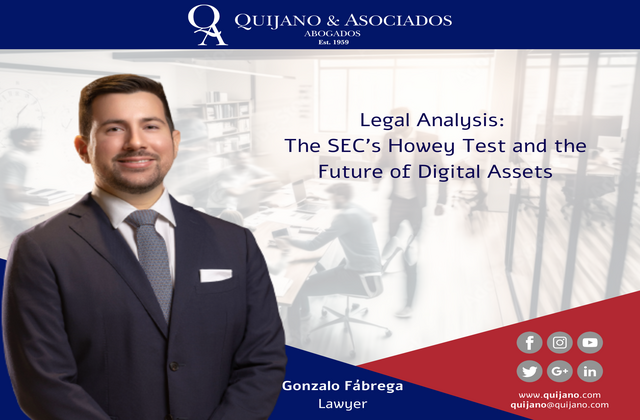Legal Analysis: The SEC’s Howey Test and the Future of Digital Assets

The U.S. Securities and Exchange Commission (SEC) has developed a framework that helps issuers evaluate whether a digital asset qualifies as a “investment contract” under The Howey Test and is subject to federal securities laws. This article analyzes the SEC’s framework for determining whether a cryptocurrency or digital asset qualifies as a “security” under federal securities laws, as well as some differing viewpoints as to the SEC’s current approach to regulating cryptocurrencies.
I. The Howey Test and Investment Contracts
The Howey test, established by the U.S. Supreme Court in SEC v. W.J. Howey Co., is the primary precedent that regulators turn to for assessing the existence of an “investment contract.” Under this test, an investment contract arises when three elements are satisfied: (1) an investment of money, (2) in a common enterprise, and (3) with an expectation of profits derived from the efforts of others.
Recognizing the unique characteristics of digital assets, the SEC has adopted the Howey test as the fundamental framework for analyzing whether digital assets qualify as securities. The SEC’s framework considers both the intrinsic features of the digital asset itself and the surrounding circumstances of its offer, sale, or distribution, including secondary market transactions.
II. Applying the Howey Test to Digital Assets
A. The Investment of Money
The investment of money requirement is typically fulfilled in the context of digital assets, as they are commonly acquired through various forms of consideration, such as real currency, other digital assets, or alternative means of value exchange. This broad interpretation ensures that the investment of money element encompasses the diverse nature of transactions involving digital assets.
B. Common Enterprise
While the Howey test does not explicitly require the presence of a “common enterprise,” courts have consistently recognized it as a distinct element of an investment contract. The SEC’s framework acknowledges that a common enterprise often exists in the context of digital assets, lending support to the potential classification of certain digital assets as securities.
C. Reasonable Expectation of Profits Derived from Efforts of Others
The determination of whether purchasers have a reasonable expectation of profits derived from the efforts of others is a pivotal factor in applying the Howey test to digital assets. To facilitate this assessment, the SEC provides a range of technical information and considerations.
- Reliance on the Efforts of Others
Evaluating whether purchasers reasonably rely on the efforts of an active participant (AP) involves analyzing the significance of the AP’s managerial efforts in the development, operation, or promotion of the network associated with the digital asset. The SEC highlights indicators of reliance on the efforts of others, including the AP’s performance of essential tasks, their role in decision-making impacting the network’s success, and the degree of control exerted by the AP.
- Reasonable Expectation of Profits
In determining the reasonable expectation of profits, the SEC’s framework considers various characteristics of the digital asset. These characteristics include the association of the digital asset with the income or profits of the enterprise, the potential for appreciation resulting from network development or positive developments, and the existence of secondary markets or platforms for trading the digital asset.
In conclusion, the U.S. Securities and Exchange Commission (SEC) has developed a comprehensive framework, based on the Howey test, for determining whether a digital asset qualifies as a security under federal securities laws. However, this framework for determining the classification of cryptocurrencies as securities has sparked debates and calls for legislative clarity. While the framework intends to provide guidance for market participants, legal experts emphasize the need for ongoing updates and clear application of the Howey test to digital assets. SEC Chairman Gary Gensler asserts that most cryptocurrencies meet the Howey test, which requires an investment of money, a common enterprise, and an expectation of profits from others’ efforts. However, some experts, like attorney Mark Bini, question whether all cryptocurrencies satisfy the Howey test, suggesting the need for updates to accommodate the unique nature of digital assets.
Congresspeople Jesús García and Stephen Lynch support Gensler’s view and argue that the majority of crypto assets should comply with existing securities laws. The SEC’s enforcement approach, which involves actions against tokens considered securities, rather than providing clear rulemaking guidance, has led to debates about the agency’s regulatory methods. Concerns about SEC overreach have been raised by Commissioner Caroline Pham, while Kevin Werbach, a professor at the University of Pennsylvania, explains that securities laws can be technology-neutral and do not always require rulemaking to address digital assets.
The outcome of ongoing legal cases, such as the Ripple case challenging the SEC’s actions, may help establish precedents for cryptocurrency regulation. Despite differing perspectives, Gensler prioritizes investor protection and emphasizes the importance of transparent disclosure, while policymakers and lawmakers argue that existing securities laws safeguard investors and prevent illicit practices associated with the crypto industry.




